Investigating Moisture-Induced Particle Behavior in a Horizontal Shaft Mixer
Abstract
1. Introduction
2. Materials and Methods
2.1. Experimental Setup and Particle Description
| Parameter | Value | Unit |
|---|---|---|
| Vessel diameter, | 109 | mm |
| Vessel length, | 170 | mm |
| Vessel Height, | 150 | mm |
| Blade pitch, | 66 | mm |
| Blade width, | 10.5 | mm |
| Outer ribbon blade diameter, | 104 | mm |
| Inner ribbon blade diameter, | 70 | mm |
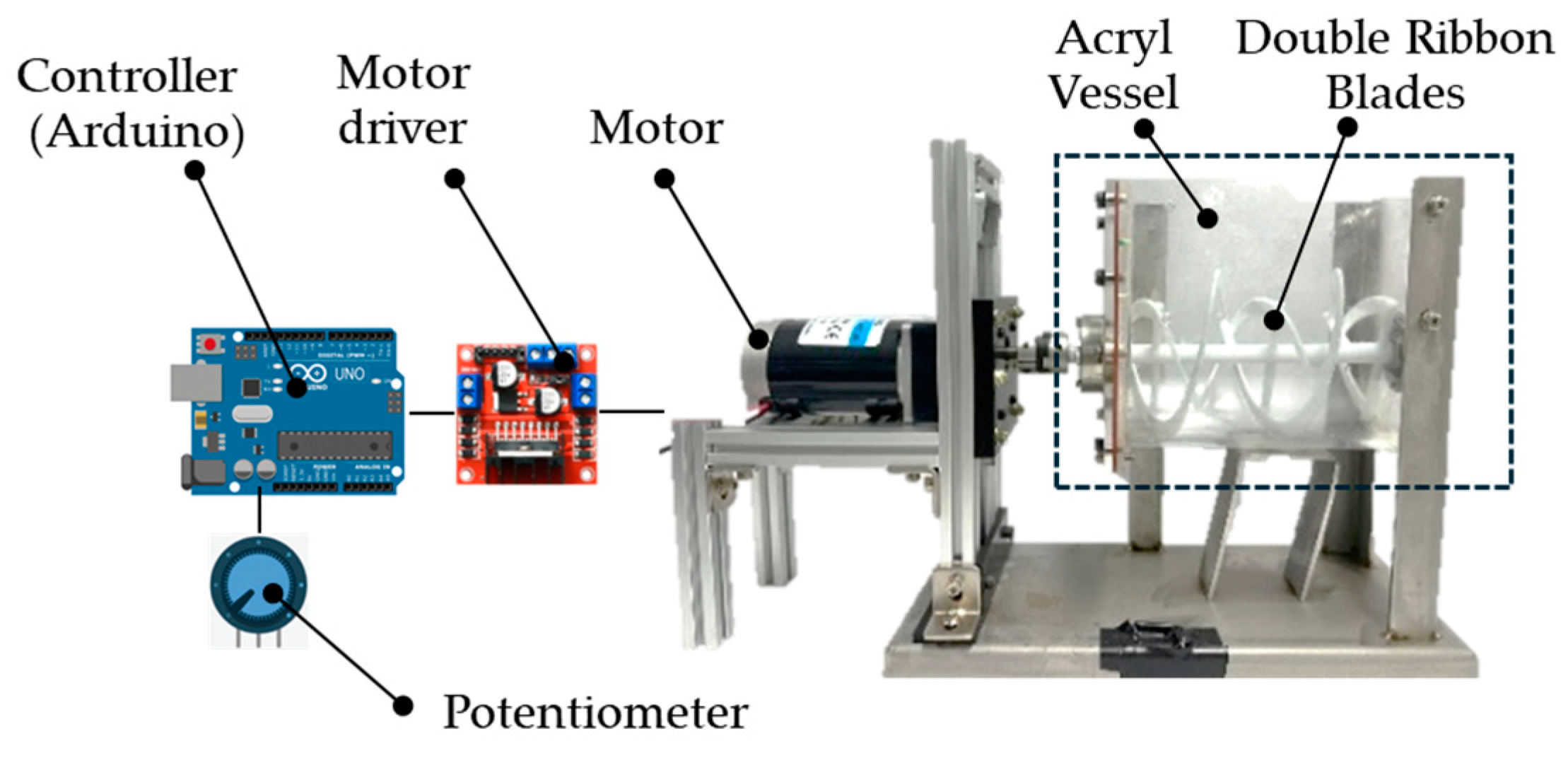
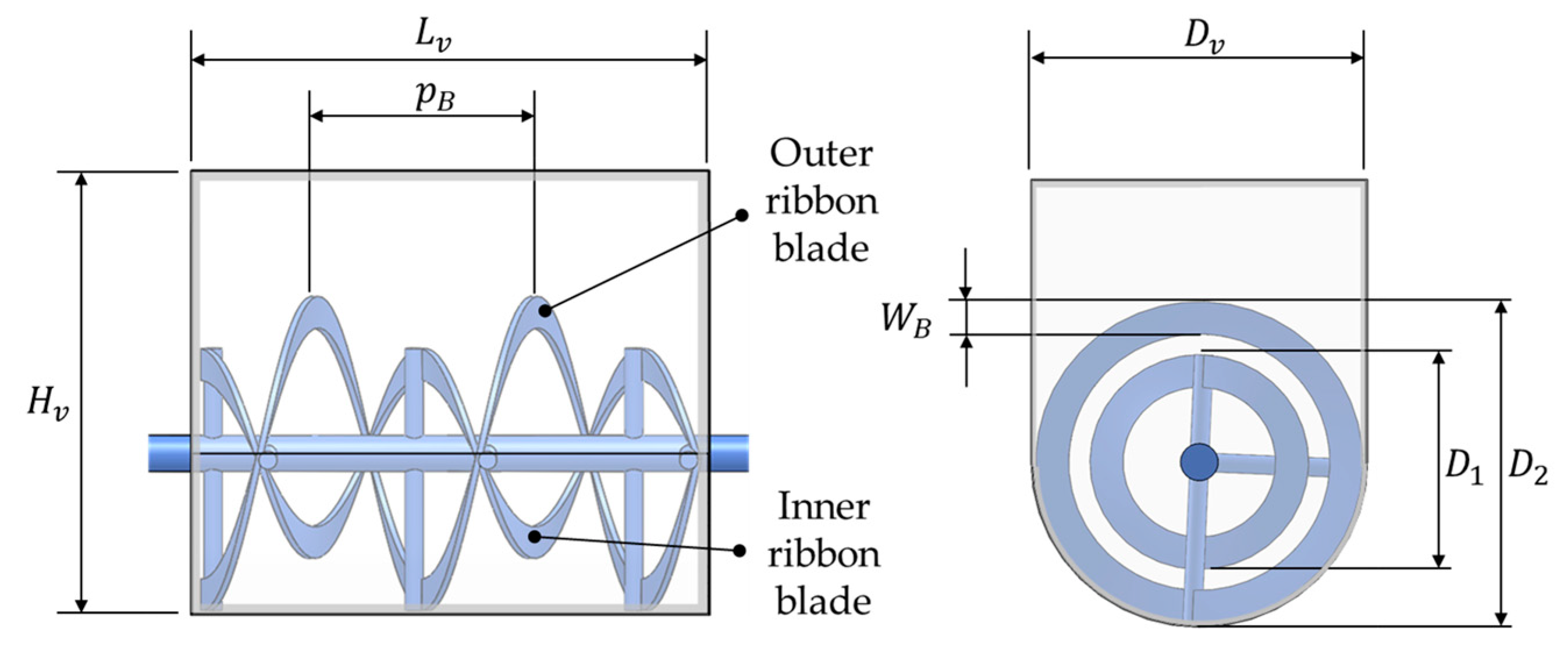
2.2. DEM Model
2.3. Mixing Index, LMI (Lacey Mixing Index)
2.4. Analysis Model
3. Results and Discussion
3.1. AOR Test

3.2. Mixing Test
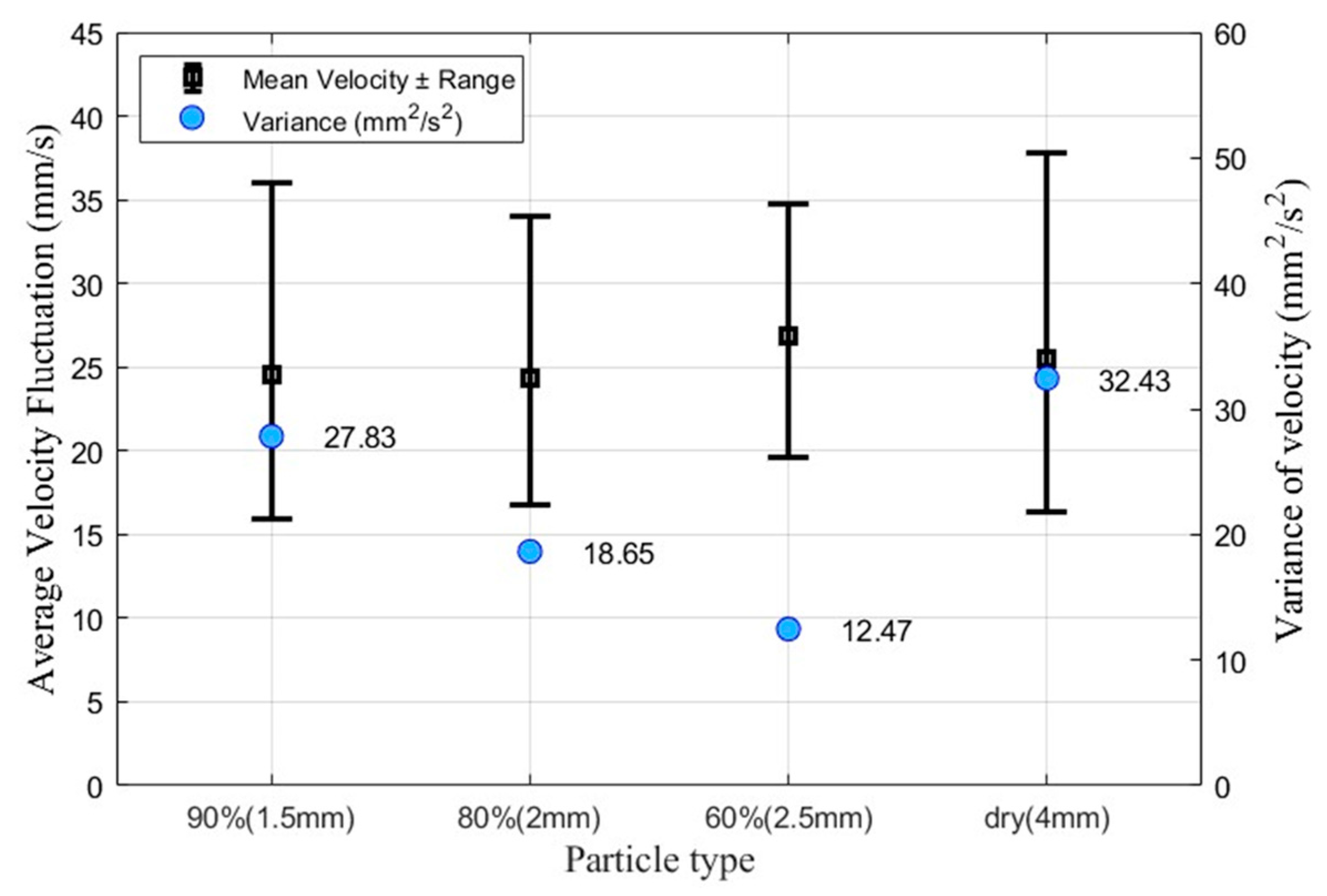
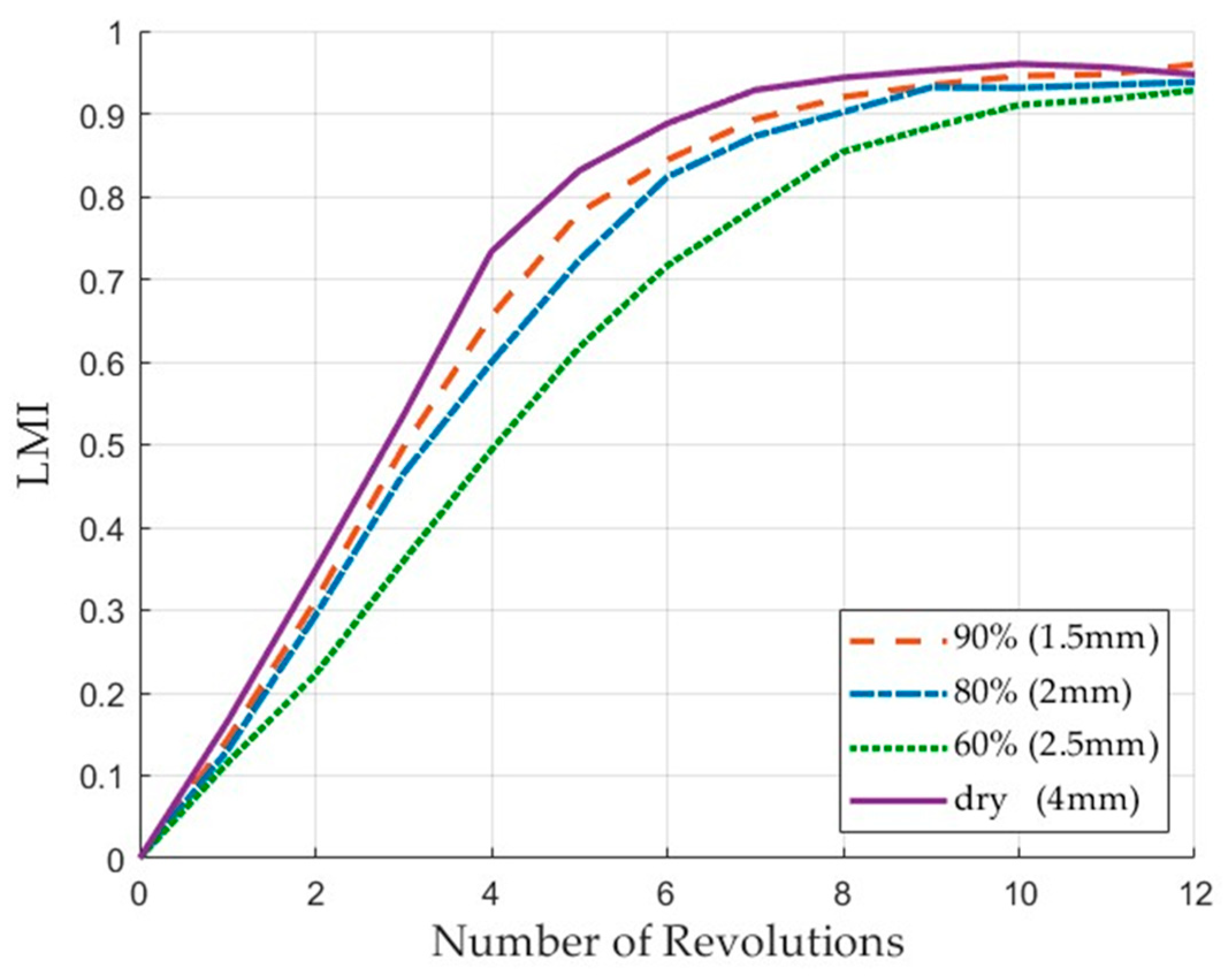
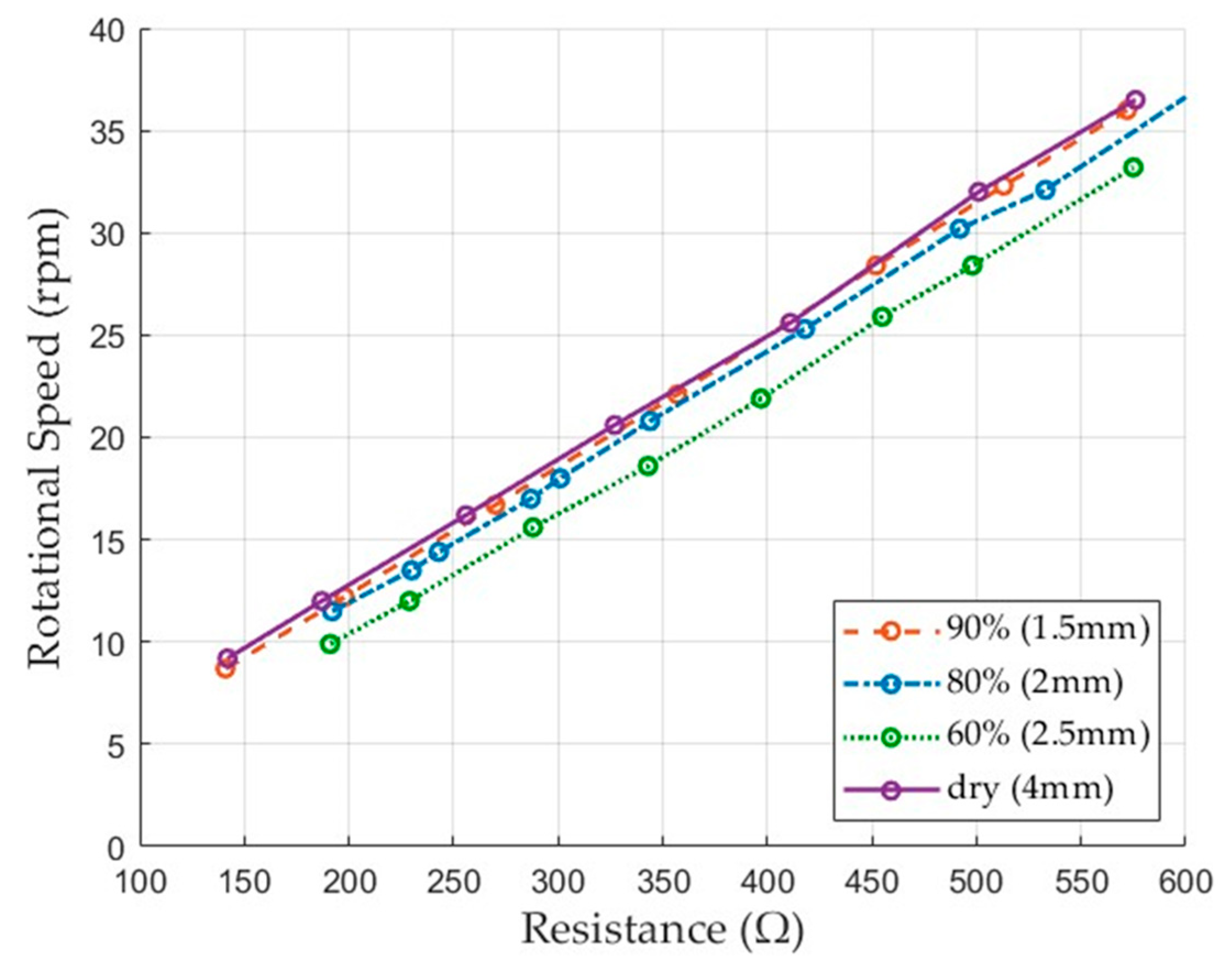
4. Conclusions
- (1)
- Among the forces acting on the particles, the main force was confirmed to be the normal force, which was the largest in 60% (2.5 mm) cases. In the case of dry (4 mm), the normal force was slightly larger than in 90% (1.5 mm), but the tangential force and adhesive force were relatively small, so it was confirmed that the mixing speed was faster.
- (2)
- The mixing of particles (LMI) progresses faster as the moving speed of the particles increases, and the mixing characteristics improve as the deviation between the maximum and minimum moving speeds increases.
- (3)
- The rotational load applied to the motor of the experimental mixer was the largest at 60% (2.5 mm), and the load was smaller at 90% (1.5 mm) due to the decrease in tangential and adhesive forces caused by the formation of a moisture film. In addition, dry (4 mm) and 90% (1.5 mm) particles showed similar resistance levels because the total force applied to the particles was similar in magnitude.
- (4)
- As a result of conducting a mixing experiment using SAP, whose friction characteristics change according to moisture content, 90% (1.5 mm) particles with the highest moisture content were piled along the side wall. In the case of 60% (2.5 mm), they were distributed more inside the container in the form of clusters rather than along the side wall. It was confirmed that the distribution patterns of dry (4 mm) and 90% (1.5 mm) were similar. This confirmed that the change in friction coefficient according to the amount of moisture greatly affects the characteristics of mixing.
Author Contributions
Funding
Data Availability Statement
Conflicts of Interest
Abbreviations
| Normal force at the time | |
| Degree of overlap | |
| Loading contact stiffness | |
| Unloading contact stiffness | |
| Dimensionless small constant | |
| E | Young’s modulus |
| r | Particle radius |
| ε | Restitution coefficient |
| Tangential force at the time | |
| Friction coefficient | |
| Coulomb’s limit | |
| rolling resistance | |
| Rolling resistance coefficient | |
| Capillary force | |
| Filling angle | |
| θ | Contact angle |
| Surface tension | |
| h | Separation distance |
| Volume of the liquid contained in the bridge | |
| Liquid absolute viscosity | |
| Equivalent radius | |
| Relative velocity | |
| Dimensionless equivalent radius |
References
- Chou, S.H.; Hsiau, S.S. Experimental analysis of the dynamic properties of wet granular matter in a rotating drum. J. Powder Technol. 2011, 214, 491–499. [Google Scholar] [CrossRef]
- Chandratilleke, G.R.; Dong, K.J.; Shen, Y.S. DEM study of the effect of blade-support spokes on mixing performance in a ribbon mixer. J. Powder Technol. 2018, 326, 123–136. [Google Scholar] [CrossRef]
- Halidan, M.; Chandratilleke, G.R.; Dong, K.J.; Yu, A.B. Mixing performance of ribbon mixers: Effects of operational parameters. J. Powder Technol. 2018, 325, 92–106. [Google Scholar] [CrossRef]
- Liu, P.Y.; Yang, R.Y.; Yu, A.B. DEM study of the transverse mixing of wet particles in rotating drums. J. Chem. Eng. Sci. 2013, 86, 99–107. [Google Scholar] [CrossRef]
- Jin, X.; Wang, S.; Shen, Y. DEM study of mixing behaviours of cohesive particles in a U-shaped ribbon mixer. J. Powder Technol. 2022, 399, 117097. [Google Scholar] [CrossRef]
- Gao, W.; Liu, L.; Liao, Z.; Chen, S.; Zang, M.; Tan, Y. Discrete element analysis of the particle mixing performance in a ribbon mixer with a double U-shaped vessel. Granul. Matter 2019, 21, 12. [Google Scholar] [CrossRef]
- Zhu, R.R.; Zhu, W.B.; Xing, L.C.; Sun, Q.Q. DEM simulation on particle mixing in dry and wet particles spouted bed. J. Powder Technol. 2011, 210, 73–81. [Google Scholar] [CrossRef]
- Wang, Y.; Xu, J.; He, S.; Liu, S.; Zhou, Z. Numerical simulation of particle mixing and granulation performance in rotating drums during the iron ore sintering process. J. Powder Technol. 2023, 429, 118890. [Google Scholar] [CrossRef]
- Kim, J.; Park, S.; Lee, D. Hygral behavior of superabsorbent polymers with various particle sizes and cross-linking densities. Polymers 2017, 9, 600. [Google Scholar] [CrossRef]
- Mitarai, N.; Nori, F. Wet Granular Materials. Adv. Phys. 2006, 55, 1–45. [Google Scholar] [CrossRef]
- Datta, P.; Faroughi, S.A. Angle of repose for superquadric particles: Investigating the effects of shape parameters. J. Comput. Geotech. 2024, 165, 105918. [Google Scholar] [CrossRef]
- Eidevag, T.; Thomson, E.S.; Kallin, D.; Casselgren, J.; Rasmuson, A. Angle of repose of snow: An experimental study on cohesive properties. J. Cold Reg. Sci. Technol. 2022, 194, 103470. [Google Scholar] [CrossRef]
- Oessler, T.; Katterfeld, A. Scaling of the angle of repose test and its influence on the calibration of DEM parameters using upscaled particles. J. Powder Technol. 2018, 330, 58–66. [Google Scholar] [CrossRef]
- Walton, O.R.; Braun, R.L. Viscosity, granular-temperature, and stress calculations for shearing assemblies of inelastic, frictional disks. J. Rheol. 1986, 30, 948–980. [Google Scholar] [CrossRef]
- Młynarczyk, P.; Brewczyński, D. Main Problems Using DEM Modeling to Evaluate the Loose Soil Collection by Conceptual Machine as a Background for Future Extraterrestrial Regolith Harvesting DEM Models. Micromachines 2021, 12, 1404. [Google Scholar] [CrossRef]
- Syed, Z.; Tekeste, M.; White, D. A coupled sliding and rolling friction model for DEM calibration. J. Terramech. 2017, 72, 9–20. [Google Scholar] [CrossRef]
- Gallego, E.; Fuentes, J.M.; Wiącek, J.; Villar, J.R.; Ayuga, F. DEM analysis of the flow and friction of spherical particles in steel silos with corrugated walls. Powder Technol. 2019, 355, 425–437. [Google Scholar] [CrossRef]
- Ai, J.; Chen, J.F.; Rotter, J.M.; Ooi, J.Y. Assessment of Rolling Resistance Models in Discrete Element Simulations. Powder Technol. 2011, 206, 269–282. [Google Scholar] [CrossRef]
- Mukherjee, S.; Thornton, C.; Adams, M.J. DEM based computational model to predict moisture induced cohesion in pharmaceutical powders. Pharmaceutics 2017, 9, 35. [Google Scholar] [CrossRef]
- Mikami, T.; Kamiya, H.; Horio, M. Numerical simulation of cohesive powder behavior in a fluidized bed. J. Chem. Eng. Sci. 1998, 53, 1927–1940. [Google Scholar] [CrossRef]
- Xiao, F.; Jing, J.; Kuang, S.; Yang, L.; Yu, A. Capillary forces on wet particles with a liquid bridge transition from convex to concave. J. Powder Technol. 2020, 363, 59–73. [Google Scholar] [CrossRef]
- Nase, S.T.; Vargas, W.L.; Abatan, A.A.; McCarthy, J.J. Discrete characterization tools for cohesive granular material. J. Powder Technol. 2001, 116, 214–223. [Google Scholar] [CrossRef]
- Lacey, P.M.C. Development in theory of particle mixing. J. Appl. Chem. 1954, 4, 257–268. [Google Scholar] [CrossRef]
- Wen, Y.; Liu, M.; Liu, B.; Shao, Y. Comparative study on the characterization method of particle mixing index using DEM method. J. Procedia Eng. 2015, 102, 1630–1642. [Google Scholar] [CrossRef]
- Jin, X.; Chandratilleke, G.R.; Wang, S.; Shen, Y. DEM investigation of mixing indices in a ribbon mixer. J. Particuology 2022, 60, 37–47. [Google Scholar] [CrossRef]
- Sekizkardes, B.; Su, E.; Okay, O. Mechanically Strong Superabsorbent Terpolymer Hydrogels Based on AMPS via Hydrogen-Bonding Interactions. ACS Appl. Polym. Mater. 2023, 5, 2043–2050. [Google Scholar] [CrossRef]
- Basinskas, G.; Sakai, M. Numerical study of the mixing efficiency of a ribbon mixer using the discrete element method. J. Powder Technol. 2016, 287, 380–394. [Google Scholar] [CrossRef]
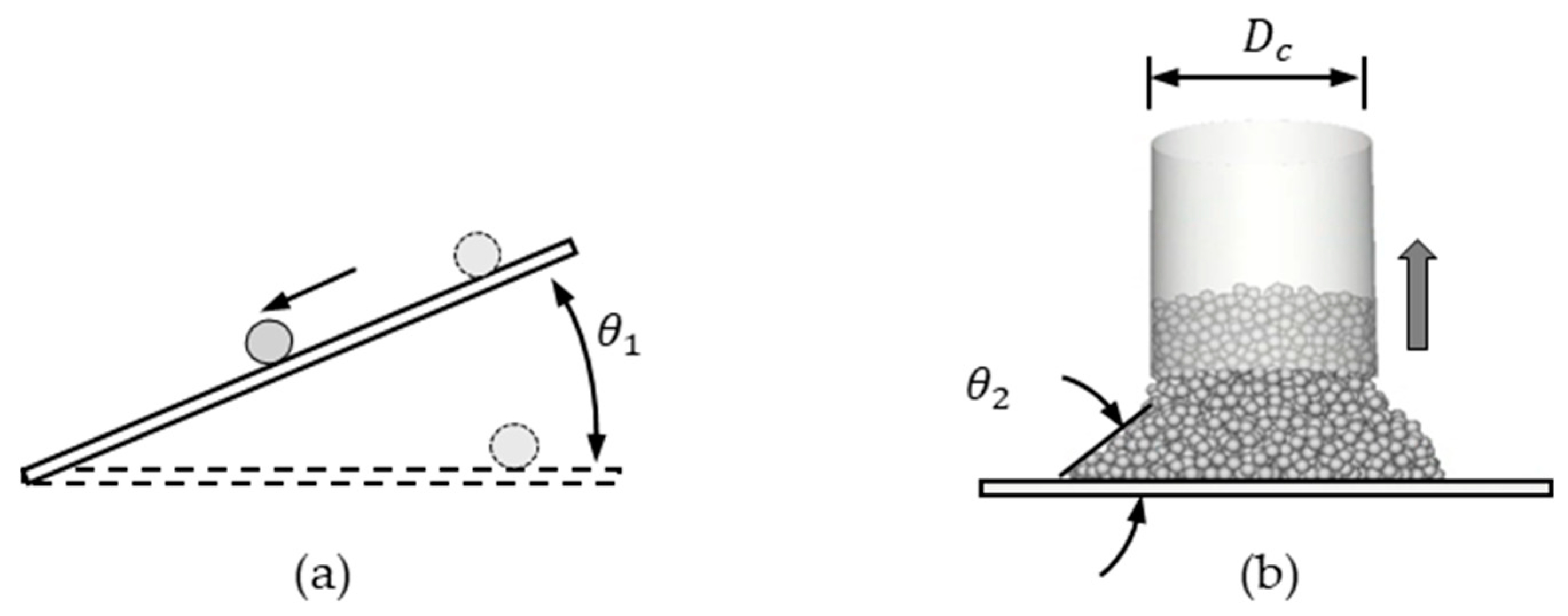
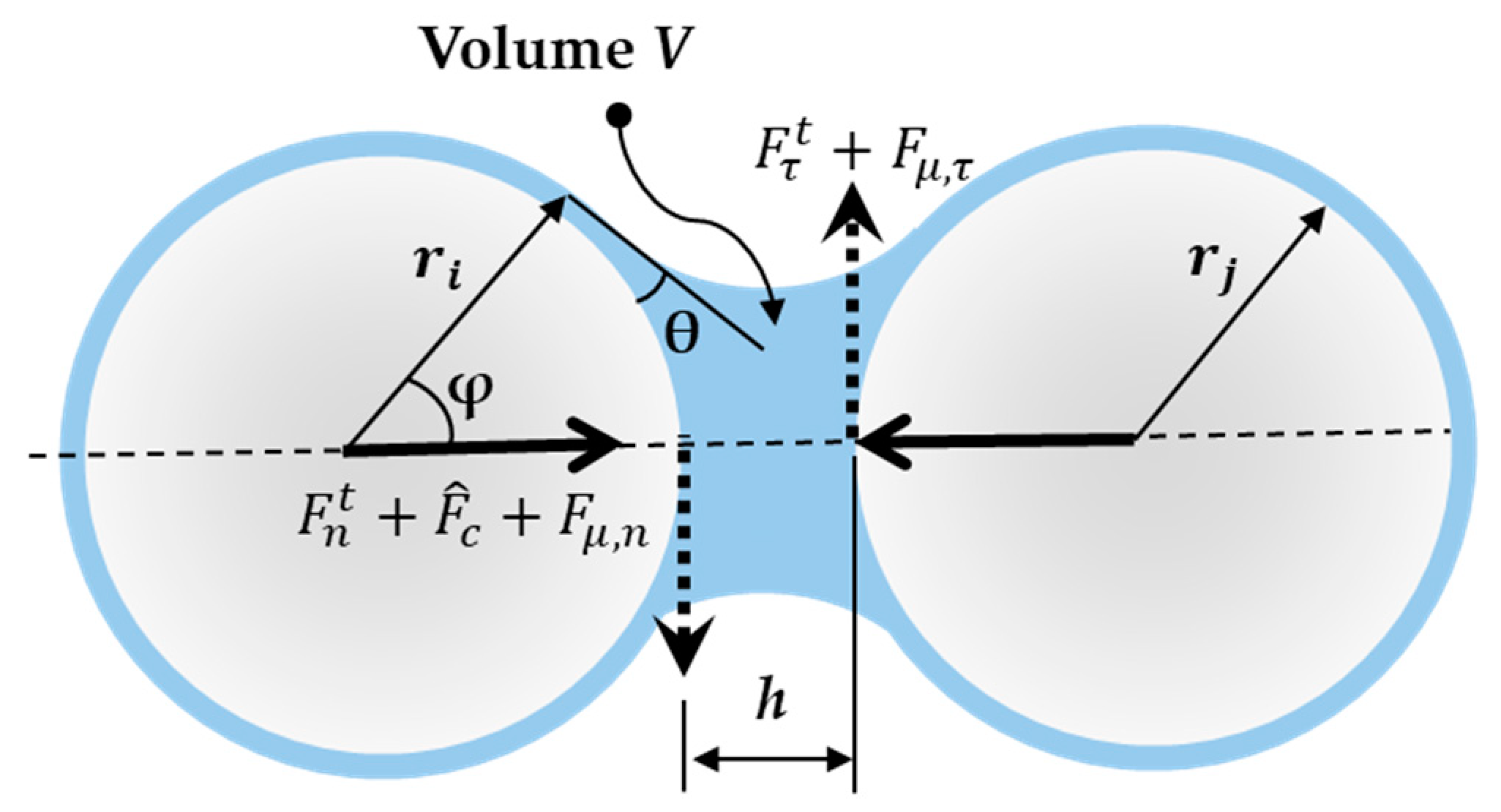
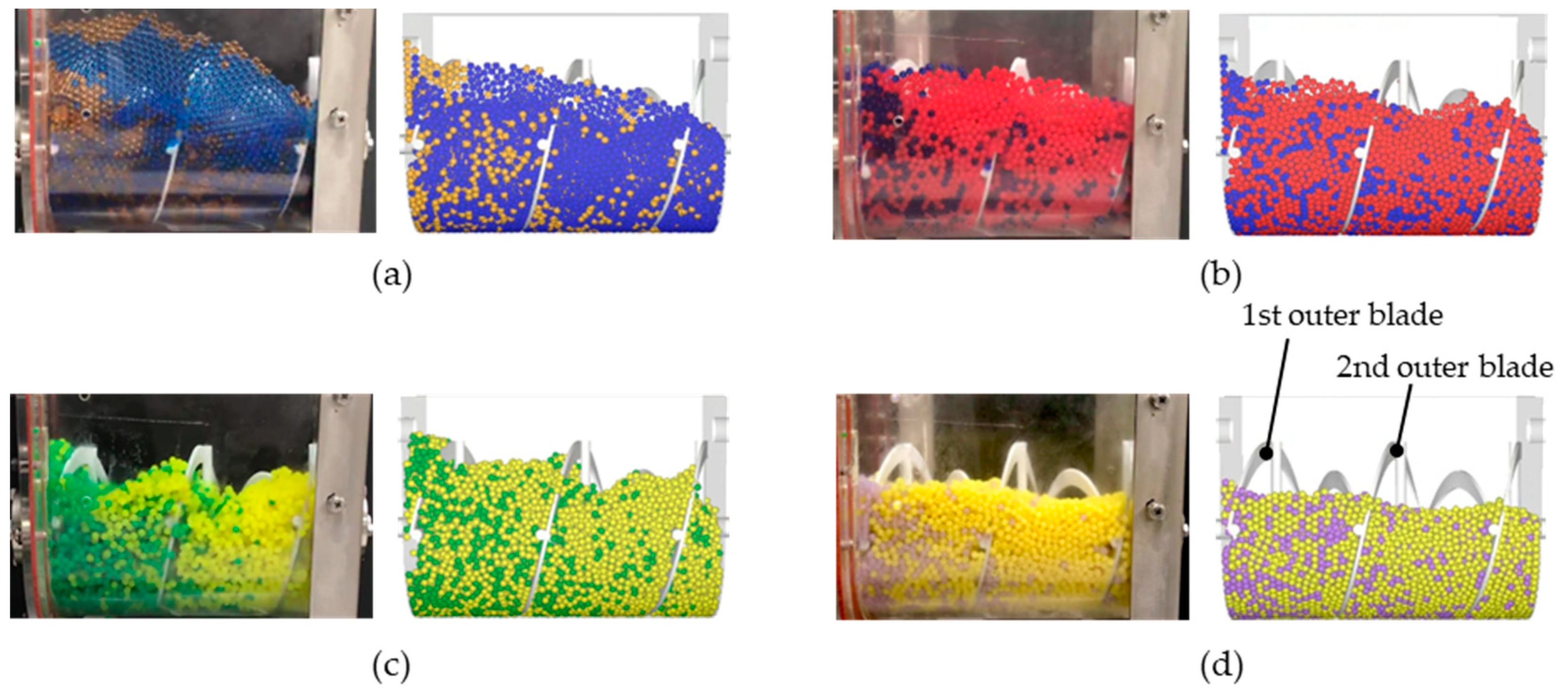

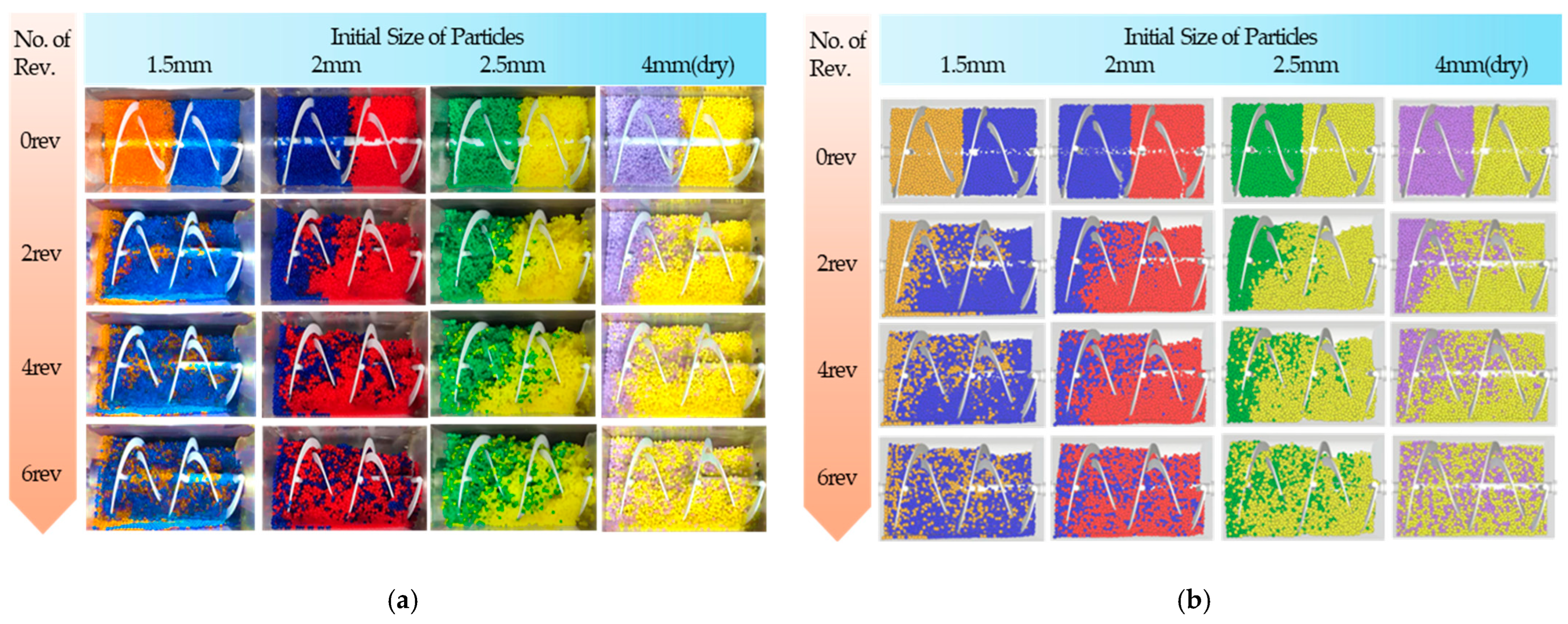
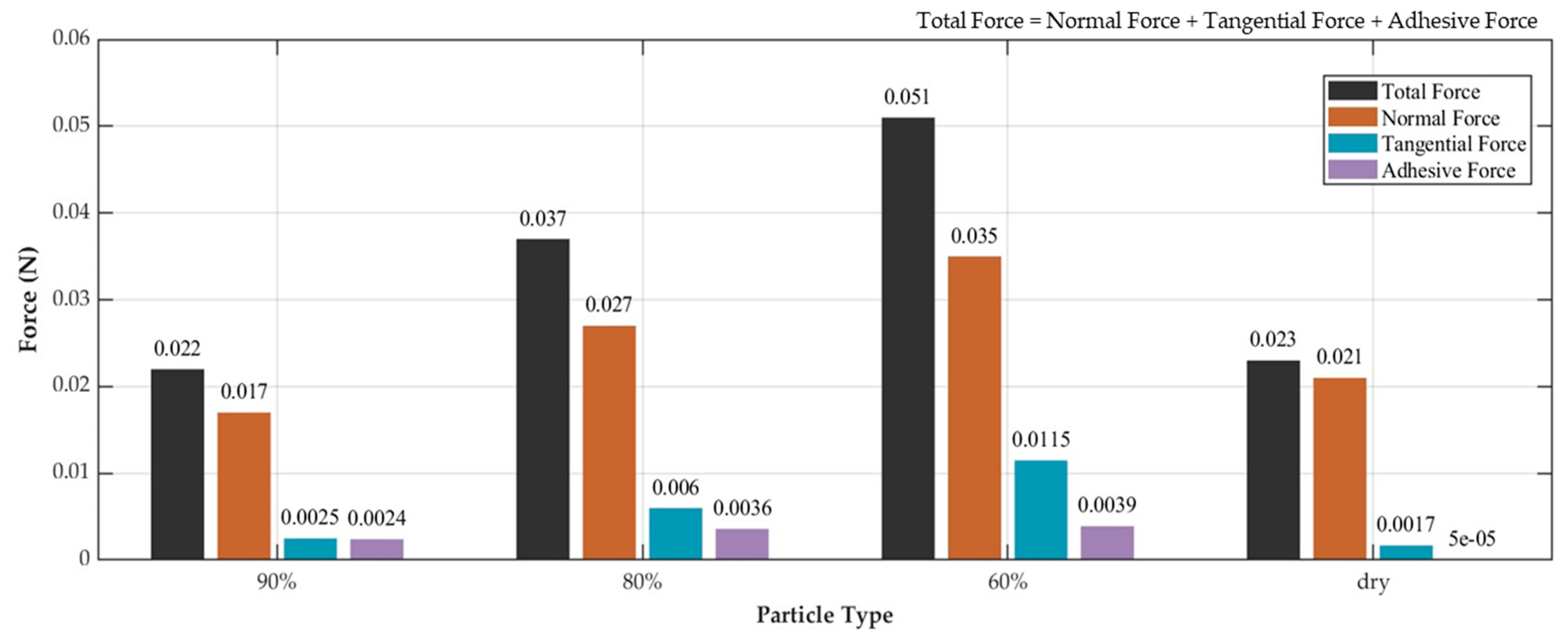
| [mm] | [g] | [g] | MC [%] | [mm] | ||
|---|---|---|---|---|---|---|
| ϕ 1.5 | 0.0071 | 0.0049 | 0.037 | 60 | 4.1 | 0.062 |
| ϕ 2.0 | 0.0193 | 0.0086 | 0.033 | 80 | 3.9 | 0.039 |
| ϕ 2.5 | 0.0254 | 0.0145 | 0.025 | 90 | 4.0 | 0.052 |
| ϕ 4.0 * | 0.0391 | 0.033 | 0 | 0 | 3.85 | 0 |
| Particle Dia. (mm) | (Degree) | ) | (Degree) | ) |
|---|---|---|---|---|
| 1.5 | 5.7° | 0.10 | 13.2° | 0.23 |
| 2.0 | 10.8° | 0.19 | 21.9° | 0.40 |
| 2.5 | 21.8° | 0.40 | 32.7° | 0.67 |
| 4.0 (dry) | 5.7° | 0.10 | N/A | N/A |
| Parameters | Particle-Particle | Particle-Wall |
|---|---|---|
| A | ||
| B | + 0.48 | + 1.2 |
| C | + 0.78 | + 0.18 |
| Parameters | Value | Unit | |
|---|---|---|---|
| Vessel (Acrylic) | Density, | 1190 | kg/m3 |
| Young’s modulus, | 3.3 | GPa | |
| Poisson’s ratio, | 0.3 | - | |
| Particle (SAP) | * Particle diameter, | 4 | Mm |
| * Particle density, | 1621 | kg/m3 | |
| Bulk Young’s modulus, | 2.5 | MPa | |
| Poisson’s ratio, | 0.38 | - |
| Parameters | Value | Unit |
|---|---|---|
| Density, | 1000 | kg/m3 |
| Viscosity, μ | 0.001 | Pa.s |
| Surface Tension, | 0.072 | N/m |
| Contact Angle, | 30 | Degree |
| Particle Type | ||||||
|---|---|---|---|---|---|---|
| Parameter | 90% (ϕ 1.5) | 80% (ϕ 2) | 60% (ϕ 2.5) | Dry (ϕ 4) | ||
| Rolling resistance, | 0.003 | 0.007 | 0.08 | 0.001 | ||
| Material interactions | Particle to particle | Friction, | 0.23 | 0.4 | 0.67 | 0.1 |
| Restitution, | 0.9 | 0.75 | 0.45 | 0.8 | ||
| Bridge Volume Fraction, f | 0.02 | 0.01 | 0.03 | N/A | ||
| Minimum Separation Ratio, h | 0.03 | 0.012 | 0.01 | N/A | ||
| Particle to Boundary | Friction, | 0.1 | 0.19 | 0.4 | 0.1 | |
| Restitution, | 0.9 | 0.75 | 0.45 | 0.8 | ||
| Bridge Volume Fraction, f | 0.01 | 0.01 | 0.01 | N/A | ||
| Minimum Separation Ratio, h | 0.012 | 0.013 | 0.025 | N/A | ||
Disclaimer/Publisher’s Note: The statements, opinions and data contained in all publications are solely those of the individual author(s) and contributor(s) and not of MDPI and/or the editor(s). MDPI and/or the editor(s) disclaim responsibility for any injury to people or property resulting from any ideas, methods, instructions or products referred to in the content. |
© 2025 by the authors. Licensee MDPI, Basel, Switzerland. This article is an open access article distributed under the terms and conditions of the Creative Commons Attribution (CC BY) license (https://creativecommons.org/licenses/by/4.0/).
Share and Cite
Sim, M.; Kim, K. Investigating Moisture-Induced Particle Behavior in a Horizontal Shaft Mixer. Fluids 2025, 10, 135. https://doi.org/10.3390/fluids10050135
Sim M, Kim K. Investigating Moisture-Induced Particle Behavior in a Horizontal Shaft Mixer. Fluids. 2025; 10(5):135. https://doi.org/10.3390/fluids10050135
Chicago/Turabian StyleSim, Minkyung, and Kwang Kim. 2025. "Investigating Moisture-Induced Particle Behavior in a Horizontal Shaft Mixer" Fluids 10, no. 5: 135. https://doi.org/10.3390/fluids10050135
APA StyleSim, M., & Kim, K. (2025). Investigating Moisture-Induced Particle Behavior in a Horizontal Shaft Mixer. Fluids, 10(5), 135. https://doi.org/10.3390/fluids10050135





